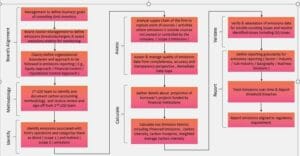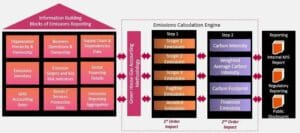
Solving the Scope 3 Emissions Conundrum

1. Executive Summary
Given that climate change is one of the biggest risks facing the real economy as well as the financial industry, there is an urgent need to measure and manage this risk (TCFD, 2017). For example, this risk may come from new regulation of a company’s high emission products and shifts in end-product market demand driven by climate concerns. One way to measure this risk is the carbon (or carbon dioxide/CO2 ) exposure of products and their corresponding supply chains
Furthermore, many companies are under increasing pressure from shareholders, investors to commit to reduction of carbon emissions, set emissions targets, periodically measure the performance of the company against pre-set targets and report progress & transition plans. Emissions reporting by organizations requires them to focus on identifying, calculating, and reporting these emissions including scope 1, scope 2 and scope 3 emissions. While measurement of scope 1 (direct emissions) and scope 2 emissions ( indirect emissions ) is relatively easy and many institutions already started publishing them in their climate disclosure and emissions targets, determination of scope 3 emissions is a complex metric and involves number of associated challenges.
Irrespective of GHG emission accounting methodology followed by firms in reporting carbon emissions, associated challenges are common and must be understood thoroughly and firms shoul plan and prepare for addressing these challenges.
In this paper, we focus on end-to-end process flow of scope 3 emissions, associated challenges existing in throughout emissions value chain and proposed functional architecture with required capability building blocks.
2. End to End Process View of Emission Analytics
Emission Analytics involves the process through which companies identify, measure, and report various emissions including scope 1 , scope 2 and scope 3 emissions and contains number of crucial points across the below 7 stages as depicted in below process flow diagram.

Figure 1 : End to End Process Flow of Emission Analytics
Compiling GHG inventory of a firm is a complex exercise and it a foundational component which enables board to define emission targets at firm level and periodically re-assess, monitor against emission targets, and create a strategic plan for de-carbonization. Typically, 1st LOD team will understand various industry methodologies available for greenhouse gas accounting and propose chosen methodology to be followed by individual firm.
Emission cycle starts from identifying emissions from various firm specific business activities and classifying them to scope 1 , 2 and 3. It is important to ensure that supply chain of the firm is being analyzed to carefully consider relevant scope3 emission activities.
As per survey conducted by CDP during April 2021, GHG emissions associated with financial institutions’ investing, lending and underwriting activities are on average over 700 times higher than their direct emissions, according to a first-of-its-kind report by non-profit CDP, which runs the global environmental disclosure system. Quantifying financed emissions is a tangible first step in building trust that financial institutions are supporting Paris agreement goals and aligned to achieve net-zero transition objectives.
In current carbon accounting models, ownership of GHGs associated with investments and lending activities is considered part of a financial institution’s carbon footprint. It is critical for firms to form a view of financed emissions by calculating its share of emissions from lending or investing activities at the sector level.
3. Challenges in Emission Analytics & Reporting
Firm’s emissions are categorized into three different scopes i.e., scope 1, 2 and 3. Operational emissions typically only cover scopes 1 and 2. Yet, scope 3 emissions are often far larger than operational emissions. Ignoring scope 3 can mean ignoring most of a firm’s climate impact. That is why the Race to Net-Zero transition requires targets that cover all three emissions scopes.
However, it is not a straightforward exercise to comply with disclosure of firm’s various category of emissions due to multitude of inherent challenges that includes addressing data gaps, handling data quality issues. While it is industry guidance to continuously strive to improve the quality of their financed emissions data, recent regulatory views suggest banks to actively engage with portfolio companies to overcome this data related challenge. Creation of accurate GHG inventory is a foundational fabric for them to run number of scenario analysis and identify suitable decarbonization pathway for various sector exposures.
Below table summarizes practical challenges faced by firms in emissions accounting and reporting. Most prevalent and notable ones like issue of double counting could be easily addressed by carefully incorporating operational and organizational boundary as part of GHG accounting methodology
| Functional Dimension | Associated Challenge |
| Complex Value Chain | Bank’s lending and investment exposure span across borrowers from multiple sector and each in-turn will have distinct upstream and downstream operations that will emit GHG gases in various intensity. |
| Lack of consistency in methodology | The lack of standardized calculation methodologies for Scope 3 emissions by companies and financial institutions |
| Complexity in collecting emission data inputs | Ability to gather scope 1 and scope 2 emissions from suppliers and chain of buyers and aggregate to product consolidated carbon metrics aligned with transition goals |
| Underlying Assumptions | When it comes to scope 3 emissions reporting validating underlying assumptions in emissions calculation is critical and firms must provide clear explanation of such assumptions |
| Recalculation of base year emissions | Structural changes ( Involves the transfer of ownership or control of emissions-generating activities or operations from one company to another) in the reporting organization that have a significant impact on the company’s base year emissions |
| Double Counting | Accounting for indirect emissions will lead to double counting when two different companies include the same emissions in their respective inventories |
| Determination of which scope3 categories are relevant for the firm | Only some types of upstream or downstream emissions categories might be relevant to the company. They may be relevant for several reasons: 1. Large relative to scope 1 and 2 emissions 2. Deemed critical for stakeholders 3. contribute to the company’s GHG risk exposure |
| Transparency with approach | Emission estimates are acceptable if there is transparency about the estimation approach, and the data used for the analysis are adequate to support the objectives of the inventory. |
Table 1 – Challenges in Emissions Analytics
4. Translated Capability View & Proposed Functional Architecture
Building a holistic emission analytics system will require critical capabilities (see Table 2) to navigate a complex landscape characterized by abundant emissions data from various activities of firm , interconnected supply chains, multiple levels of organizational boundary and operational boundary, to deliver the desired outcomes.
| Capability Building Block | Component | Translated Capabilities that Bank Needs to Develop |
| Data Sourcing | Gathering Emission Data | Capability to gather data from obligor both companies’ and supply chain entity’s scope 1 and scope 2 emissions |
| Data Aggregation | Data aggregation and Reporting | Aggregate emissions data across counterparty’s operation, geography, asset type, business divisions , sector and sub-industry & report the same |
| Risk Assessment | Materiality Assessment of Emissions | Process to determine and evaluate emission thresholds against predefined quantitative emission threshold |
| Data Attestation | Attestation of Emissions data | Framework to enable attestation of emission metrics by independent third-party firm and address review feedback |
| Data Quality | Data Quality and reconciliation | Framework to validate data quality of input emissions data and reconcile with emission data from counterparties , remediate data quality issues |
| Reporting of Emissions | Taxonomy Alignment | Aligning to industry taxonomy standards and report emissions metrics at sector , industry, and sub-industry levels |
| Metrics & Targets | Key Risk Indicators & Metrics | Framework to identify and select suitable key risk emission metrics and targets to monitor firm level performance to enable Net-Zero transition |
| Computation & Analytics | Financial Impacts Calculation | Calculation modules to determine GHG emissions in connection with their lending, investment, and underwriting businesses |
| Computations & Analytics | Emission Calculation | Rule engine that incorporates consistent set of rules to compute scope3 emissions by aligned specific methodology (e.g., PCAF, GHG Standards etc.) |
Table 2 – Translated Capability View
US Federal Reserve has recently published proposed rule on the topic ‘’ The Enhancement and Standardization of Climate-Related Disclosures for Investors’’ and it has requirements around disclosing emissions across 3 scopes, disclosing attestation of emissions data from received experienced assurance providers. To improve accuracy, comparability, and consistency with respect to the proposed GHG emissions disclosure, US Fed is proposing to require a minimum level of attestation services for emissions data.
Institutions must better understand capabilities required to tackle various emissions disclosure requirements which included automated technology components to source multiple types of data from various sources, integrate them to build integrated emissions layer. It is critical to ensure that input data feeds are accurate calculation of metrics. Calculation layer involves determining scope 1 , 2 and 3 emission values as absolute metrics and followed by more relevant derived metric including financed emissions, carbon intensity and carbon footprint.
Firms must define key risk indicators for managing carbons risks and proactively monitor performance of company’s emission range against pre-defined targets. Existing risk management capabilities of the firm could be leveraged to effectively build target state emissions reporting analytical system.

Figure 2 – Proposed Capability Framework View
5. The Bottom Line
Given the rapid increase in regulatory focus around managing financial risks due to climate changes and ever-increasing shareholder’s demand for clear and detailed carbon disclosures, companies must proactively plan on reducing carbon footprint by setting carbon targets and need to effectively monitor & disclose emissions. As this domain is evolving along with regulatory pressure around it, firms must disseminate best practices with peer firms to advance global thinking on how to manage emissions and plan for decarbonization. Companies that is well prepared to build systems that creates reliable and comparable emissions reports will gain a competitive advantage and steal a march over their peers
Author’s Bio:
Sudalaimuthu Gurusamy is a Domain Consultant with the Risk Management practice of the Banking and Financial Services (BFS) business unit at Tata Consultancy Services (TCS). During his 13 years of experience in consulting, he has worked on several global risk and compliance engagements as Risk Domain Consultant/Senior Business Analyst.
A GARP certified Financial Risk Manager™ and Sustainability & Climate Risk™ professional, Sudalaimuthu holds a master’s degree in Business Administration from the Anna University, Chennai, India. His risk consulting experience revolves around Credit risk Transformation, Risk Data Transformation Initiatives, BCBS 239, BASEL II, BASEL III, Liquidity risk management, Loan loss forecasting and provisioning, and risk regulatory reporting. Recently he is working on developing risk solutions to cater to emerging risks domains including operational resiliency & climate risk.


